How Daily Habits Can Improve Your Health

Every day, whether consciously or unconsciously, we cultivate habits. Some, like bathing and brushing our teeth, are so ingrained we don’t give them a second thought. Others require a little more discipline at first, but once well-established, we can’t imagine going without them. Daily meditation is a good example of this. Other habits, like our four-cup-a-day coffee routine, may not serve our best interest or greatest health.
Ayurveda, one of the world’s oldest systems of health, embodies the old adage, “An ounce of prevention is worth a pound of cure.” The word “ayurveda,” meaning science or sacred knowledge of life and longevity, believes spending a few extra minutes per day can prevent illness and disease down the road, adding up to great health savings. In ayurveda, there are six stages of disease, beginning with a simple and subtle imbalance in doshas (particular constitutions of the body), which, if left untreated, progress to severe illness and disease. The better we are cultivating daily habits to abate imbalances when they first occur, the less likely disease is to manifest in the tissues and, ultimately, organs of the body.
To this end, ayurveda promotes daily habits, known as dinacharya, to ensure good health year-round. In addition to positive physical results, these habits can offer stability and grounding no matter what kind of chaos may ensue after the first couple of hours of your morning. Much like making your bed, morning ritual sets a tone of peace, balance and intention for the day and is an integral tenant of ayurveda.
Below are a series of techniques that purify and nourish the body. Many of these techniques cleanse the body of unwanted toxins accumulated throughout the evening, while others restore vitality to the body.
1. Tongue Scraping
This is by far one of the easiest and quickest methodologies ayurveda offers. Brushing the tongue does not have the same effect because it may simply push toxins back into the body. Scraping the tongue back to front with a metal scraper helps remove the ama—a byproduct of poorly digested food that can get stuck in the organs and channels of the body. Ayurvedic wisdom often points to ama as the underlying cause of all disease. So get that stuff out when you can.
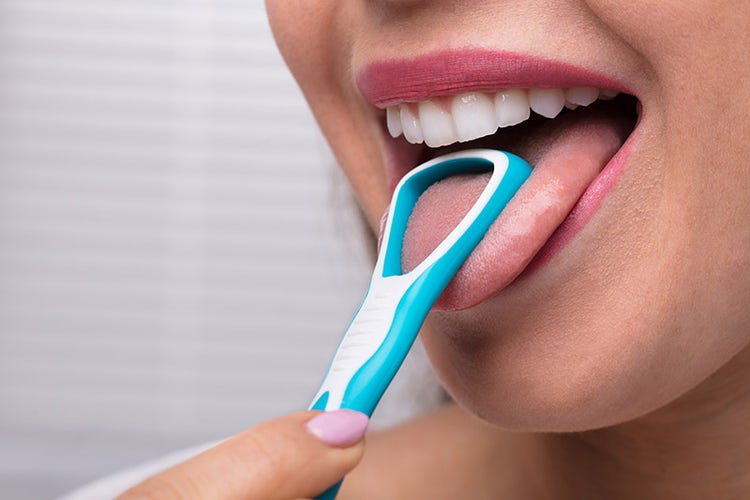
2. Neti pot
Most people only think to use a neti pot when they have a cold. In truth, daily rinsing of the nasal passages helps clear out debris, pollen and any other bacteria. It can improve sense of smell, thereby heightening taste, and if you practice pranayama (breathing techniques) and meditation, it’s an excellent way to clear the energetic pathways to support your practice. You can purchase neti salt with a measured spoon (usually about ¼ teaspoon) and mix with 1 cup warm distilled water. (If you boil the water, make sure it cools.) A ceramic pot is best for home use, while a plastic pot is excellent for travel.
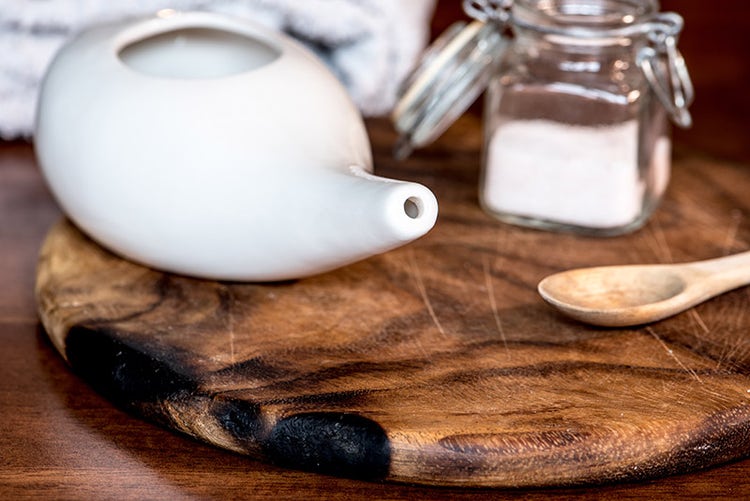
3. Warm water with lemon
Taking a cup of warm water with fresh lemon (juice from ½ lemon should do the trick) can assist morning evacuation and hydration. Since ayurveda also promotes a very light breakfast early in the morning (digestive fire is at its peak between the hours of 10 a.m. and 2 p.m.), this can help you feel more full and diminish the need to eat immediately.
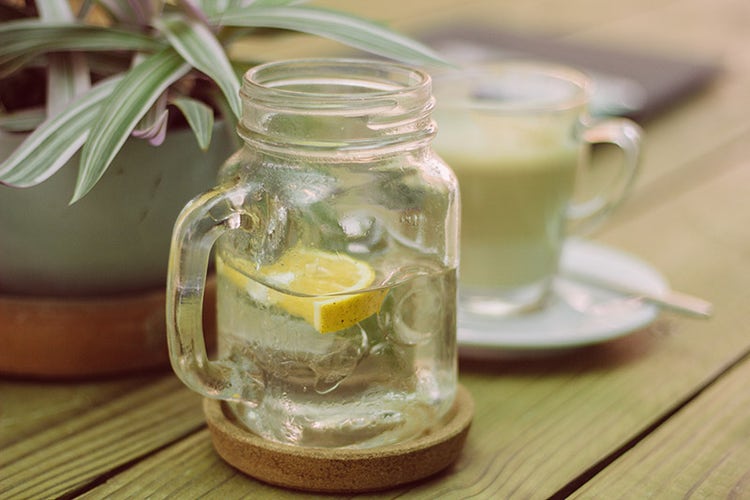
4. Dry brushing
Your skin is your body’s largest system of detoxification. Sloughing off dead skin cells every day, again, assists the body in removing ama and also can support lymphatic circulation and increase energy. Of course, removing dry skin can improve the tone and texture of your skin. Dry brushing is best done before showering sans any lotions or oils. Use circular strokes around the stomach and joints and long sweeping strokes on the arms and legs, and always brush toward the heart. Look for natural bristles that aren’t overly abrasive. If you are prone to anxiety or feel jittery, only dry-brush two to three times per week and make sure you follow up with an oil massage (below).
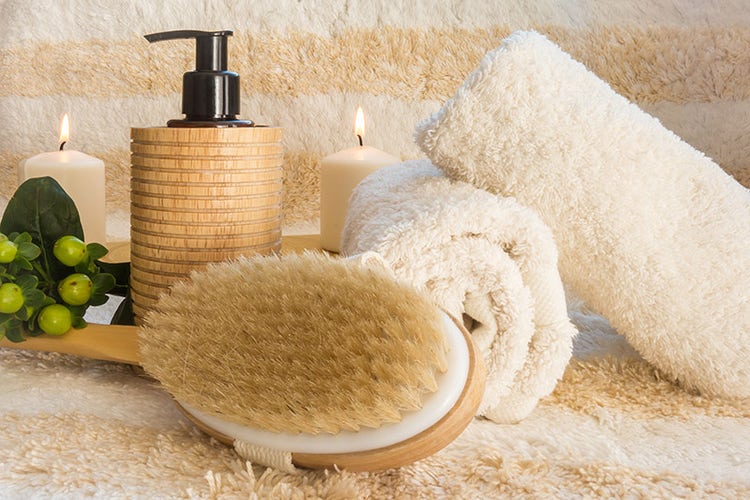
5. Abhyanga
One of ayurveda’s most prized rituals, abhyanga, or oil massage, has numerous benefits. On the surface, it improves the softness, strength and luster of the skin. It also can stimulate the internal organs of the body, increase circulation, alleviate stiffness and fatigue, enhance vision, and aid with sleep. Warm ¼ to ½ cup oil in a bottle by placing it in a pot with hot water. Sit on a towel you don’t mind getting messy. Massage the oil into the body like dry brushing—long strokes toward the heart on the limbs and circular patterns around the joints. Use broad circular strokes, particularly around the digestive track, moving up the right side of the abdomen, across the top and down the left side. The type of oil you use depends on your dosha, or constitution. Sesame oil is more warming and great for vata and kapha. Coconut oil is lighter and more cooling for pitta. You can take a brief quiz here that will help you determine the best choice for you. Massage your body for five to 20 minutes. If you can, include the head and hair and inside the ears, as well. If you don’t have the time for a full-body massage, try massaging just the feet instead and put on a pair of socks for five to 10 minutes.
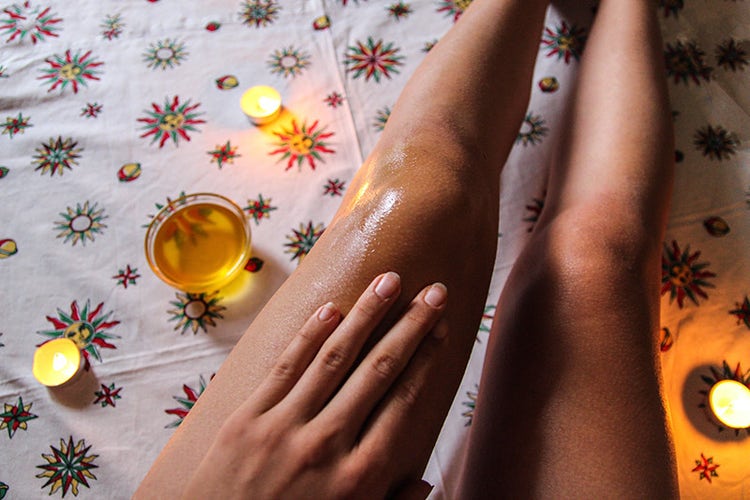
6. Meditation
It’s no longer unusual to see meditation in a list of daily habits. Cultivating a daily mediation practice is known to increase contentment, peace and stability in everyday life. It is a top technique to enhance self-awareness, promote clarity and insight, and reduce anxiety and fatigue. There are so many different styles of meditation, and you’d be best served to find one that resonates with you to increase the likelihood of a daily practice. Even 10 minutes a day can rapidly begin to shift your mindset and consciousness. Try meditating after abhyanga, and let the oil penetrate into the tissues of your body as you tend to the care of your mind. If you need some guidance, try an app such as Sanctuary, Insight Timer or Headspace.

7. Shower or bath
It seems like a no-brainer, but a shower or bath after a morning oil massage and meditation removes the oil from the body and feet and leaves them silky smooth. Warm water is best for vata and kapha types, while cooler water is suggested for pitta, and because ayurveda believes anything that enters our skin is eventually assimilated by the body, it is recommended to use the most natural and least-toxic cleansers available.
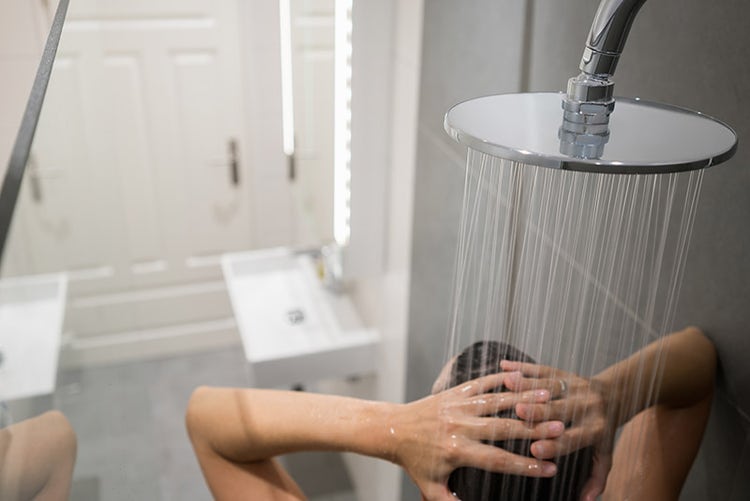
If all this seems overwhelming—like establishing any other new habit—start small. Pick one or two practices you can incorporate consistently with confidence. Once those are second nature, like brushing your teeth, consider adding another. Before you know it, you’ll have a self-care routine down pat that you won’t recall how you ever lived without.
Also, while many of these habits are easily done in the morning—for example, I wake up, tongue-scrape, use the neti pot and drink my warm water with lemon, which only takes about three to five minutes—you may want to sprinkle in some of the other practices throughout the day or in the evening. Personally, I love a warm bath with soothing and relaxing essential oils before bed along with a cup of chamomile tea. Often, I will massage my feet with some oil, put on socks and slide under the covers for a short evening meditation. It’s a wonderful way to ensure a solid and restful night’s sleep. Again, everyone is different and keeps different schedules. Do what you can and when you can, and remember good habits are established through repetition. Your body, mind and soul will thank you, as you’ll find more peace, ease and stability throughout your day and your life.
Want to learn more about ayurveda and its foundational principles? Banyan Botanicals is a wonderful resource for all ayurvedic products and wisdom, but many products also can be found on Amazon.
Video credit: AntGor, Shutterstock
Photo credit: Rawpixel, Getty Images; Andrey_Popov, Shutterstock; MandriaPix, Shutterstock; Lauren Bow, Unsplash; Anna Soelberg, Shutterstock; POLIGOONE, Shutterstock; stockfour, Shutterstock